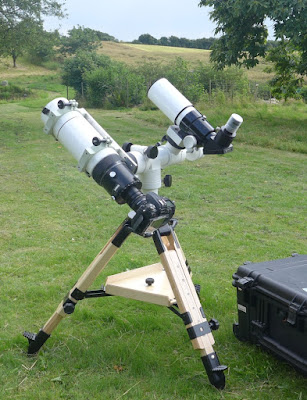The new tripod and alt-az mount has arrived and look very nice - great workmanship and finish. The compactness of the tripod and dual-scope capacity of the mount will do wonders in reducing the amount of gear I need to haul along. I am using a simple aluminium plate to connect the Borg refractor to the mount - it needs to be offset pretty far from the mount to ensure proper balancing.
 |
| Berlebach tripod and TS AZ5 mount with the two refractors that I'll be using for the upcoming total solar eclipse. |
Next step is to connect all the parts and do some field testing of the imaging setup. I need to find out if the setup suffers from vibrations and investigate if the optical quality of the 4" f/4 refractor is OK. Doing this is really simple: just set up like it's a total solar eclipse, point the scope at Vega and run the Eclipse Orchestrator script. This script runs through a number of exposures, ranging from 1/800 to 1.3 second. The short exposures will primarily sample the optical quality while the longer ones will be sensitive to vibrations.
 |
| In-focus stellar images taken with Borg 4", f/4 refractor. Scope was not collimated prior to this test. |
I focussed the scope using a zoomed liveview display on my laptop. A bright blue halo appeared around Vega at focus and the highly out-of-focus image was not perfectly round. This is not indicative a excellent optical performance! I was in a hurry, so I pressed on running the script. Below are shown six images from the run; three at 1/320 second exposure and three with 1.3 seconds. Each series shows the same star which is near the center of the field. From these shots I conclude:
- The short exposures are generally sharper and more variable - both effects are due to atmospheric seeing.
- The short exposures reveal an asymmetrical halo - this is likely due to optical misalignment within the scope.
- The long exposures show no signs of vibration
The refractor used for this test consists of a Borg 4" f/6.4 ED lens coupled with field corrector and reducer lenses to yield f/4. Such a fast configuration does require careful attention to mechanical alignment of the optical elements - and I did none prior to this test. I have previously done tests at f/6.4 where I could reach FWHM=3.2 pixels.
Next step is to try and improve the collimation of the f/4 configuration - if I can't get it satisfactory I'll go for f/6.4 and the sharper images. Perhaps it would also be beneficial to use a filter to reduce the blue wavelengths - this is known to improve contrast with achromatic and ED refractors.
No comments:
Post a Comment